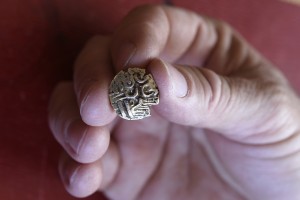Jean-Pierre Riber, writer, topchef, and quiche Lorraine expert, welcomes us to the charming Alsace village of Meyenheim. At his ancient family farm, built in 1556, he tells us about his rather surprising passion for coins with minterrors.
Monsieur Riber, what is a coin with a minterror?
Quite simply, it is a coin with a faulty inscription.
How did you start your collection? I assume you were not always enthusiastic about numismatics and its flaws?
I started when I was six. In the kitchen of our family farm there was a metal box that, to me, made a magical sound. This box contained coins that my grandfather had brought home from various countries during the First World War. In particular, it contained old 10-centesimi coins from the 19th century, that is from the reigns of Italian kings Emmanuel II and Umberto I. When my grandfather gave the box to me, I was fascinated by the thought of the long history behind these coins. I still own them, they are the centrepiece of my collection and I will never part with them. My enthusiasm for numismatics definitely became firmly established at the age of ten. I would accompany my father when he delivered grains, and we would regularly encounter a fine gentleman who enjoyed asking me, the boy, about my knowledge of French history. Surprised at how much I knew, he showed me a small silver Louis coin minted in 1720 in Strasbourg and gave it to me as a gift. I was fascinated, felt a calling and put aside my other collections of stamps, old postcards and fossils, in order to dedicate myself exclusively to numismatics.
How has your collection developed?
After 40 years of passionate collecting, it now consists of more than 1,000 pieces! You start by combing flea markets, reading magazines about the topic, studying catalogues from auction houses and meeting other collectors, and then you begin to specialise over time. I am curious by nature, and it would take several lives before I could claim to have fully mastered the science of numismatics – after all, it extends to history, geography, mathematics and many other aspects of life.
How do you expand your collection?
I buy only for pleasure and to finish a book I have been working on for more than 20 years, and that will be my life’s work: a directory of coins with mint errors from 1515 (King Francis I of France) to the present day. Collectors rarely swap their pieces. I buy my treasures from special dealerships, private persons, antiquarian bookshops specialising in numismatics, and from auctioneers’ catalogues. I bought two coins at Dorotheum at the end of May 2015: one undated “Ferdinand II. thaler, no year, Klagenfurt, with title of Emperor and King” that bears the inscription Avstriae with an additional A and V; and one “Saxony, Albertine line, August 1553–1586, thaler 1557, Dresden”, embossed with ROIMA instead of ROMA. At the famous auction of André Breton’s estate in April 2003 I bought an antique gold coin that dates from the time of the Ambiani and the Atrebates, Celtic tribes from Belgic Gaul. This coin, over 2,000 years old, has a really contemporary design; the surrealists would have liked it.
I also own a very rare coin with a mint error that was made for Louis XVI and is missing the V, so it appears to be dedicated to Louis XI. There are only seven specimens of this coin in the world, and I own one of them!
Have you made any special discoveries?
I am a real coin hunter, sometimes I track things down that others cannot see. I once met a collector who showed me a piece that he knew nothing about. I recognized immediately that it was a “thaler klippe” [square or polygonal coins whose flans, i.e. the as yet unminted coin blanks, were made with clipping shears, ed.] that was mentioned in a work by Arthur Engel in 1876; it was a rare example from the Rencker collection, and of course I bought it straightaway. I have also been lucky enough to add a special book to my possessions that was left over at an auction in Lyon. It is called “Traité de la cour des Monnoyes et de l’estendue de sa jurisdiction” and was written by a certain Maître Germain Constant, advocate at the Parlement of Toulouse, who published it in 1658. It weighs six kilograms and numbers more than 1,000 pages. A real encyclopaedia for numismatists!


The interview was conducted by Joëlle Thomas, representative of Dorotheum in Paris.
(myART MAGAZINE Nr. 07/2016)
Jean-Pierre Riber admits that an interest in coins with minterrors is a rather elitist hobby. He nevertheless hopes to find collectors to whom he can pass on his expertise, and with whom he can share the “hunt for knowledge” that was so popular with Michel de Montaigne and that provides time and space in which to disappear.
Browse the Dorotheum myART MAGAZINE online or view older issues on Dorotheum.com!
image above
Jean-Pierre Riber © Christian Sarramon












